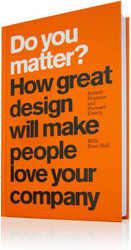Do you matter ? How great design will make people love your company

Comment fidéliser ses clients ou en attirer de nouveaux. Comment être certain que les produits ou les services qu’une marque propose les touchent réellement, au point qu’ils soient investis dans son succès à long terme.
C’est le propos d’un ouvrage, intitulé Do you matter ? et coécrit par un ancien directeur du design de chez Apple. Structuré en 9 chapitres, celui-ci part d’un questionnement large, consistant à dire que le design, en tant que tel, interroge (design matters), pour aboutir à la présentation d’une stratégie permettant de construire une « Design-drivent culture ». Quelques notions clés y sont progressivement abordées, par le biais de retours d’expérience notamment.
Le lecteur y comprend ainsi de quelle manière les produits « parlent » aux consommateurs, et doivent être considérés comme des portails (« products as portals »), ou plutôt comme des interfaces entre une marque et son identité d’un coté, et de l’autre l’expérience qui en est fait chez l’utilisateur.
On y apprend aussi comment ce type de design, intégré dès le départ de la conception des produits et intimement lié à la stratégie d’entreprise, contient une part de risque, considérée comme un atout pour rebondir vers d’autres pistes de développement.
Egalement, on y découvre une volonté forte d’établir un dialogue avec les futurs utilisateurs, les auteurs affirmant par exemple qu’il est impossible, dans une compagnie « orientée design », de ne pas trouver quelqu’un dont le travail soit approximativement celui de « chief experience officer » (p.70).
Contenant un certain nombre de propos incantatoires concernant le rôle et les (prétendues?) vertus du design, l’ouvrage n’en reste pas moins riche de conseils, lucide et précis dans ses analyses. Multipliant les exemples – Samsung, Starbucks, Apple, IBM, Ikea, Virgin… – les deux auteurs donnent ainsi, dans une vision très anglosaxonne du rôle du design mais particulièrement bien construite et intelligible, les clés d’une stratégie orientée design, dans laquelle la notion d’expérience vient remplacer la simple vente de produits ou de services.
Do you matter ?, par Robert Brunner et Stewart Emery (avec la participation de Russ Hall), FT Press, 240 pages (n&b), en anglais, 12,95 euros.
Un site Internet, dédié à cet ouvrage, est accessible en ligne. Il en présente quelques extraits, ainsi qu’une présentation de ses auteurs: doyoumatter.com.
———–
Quelques extraits :
« Great products are about ideas; they are not just objects » (p.12)
« You matter to your customers to the degree that they become emotionally invested in your continuing success – when they want you to win » (p.20)
« Apple did not invent what became the iPod. Instead, Apple developed the iPod as a portal ton an incredibly valuable ongoing consumer experience » (p.41).
« If you want to transform your brand to the point where you matter, you have to start with design that is « designed in » not « added on »". (p.46)
« Design is a living, ongoing process that has to learn from mistakes, refresh itself and take new risks all the time » (p.55)
« Design driven companies focus on people throughout the process. That’s what drives development. It all comes from the idea of creating an emotional response ». (p.58)
« Design driven company manufacture to the way they design instead of designing the way they manufacture » (p. 73)
« Being design-driven is a process, not an event » (p.91)
« When your brand communicates, you create a context of expectation. The product is emotionally prequalified before the purchase is made » (p. 107)
« Really well designed products or services become an icon and a venue, a door-way or portal for a specific community to a unique experience » (p.134)
« Don’t play the game, change the game. Look to design to uncover new territory » (p.136)
« Customer experience supply chain management starts with the en in mind – what the customer fells, sees, hears and touches » (p.142)
« The thing that is hard for most business people to grasp is that the design is there to tell a story. It takes a customer’s need or desire and spins its story all the way to an expected fulfillment » (p.160)
« All products communicate with customers. But you don’t have to look hard to see many do that poorly, or spin the wrong story, or make promises that can’t be kept » (p.162)
« Whereas almost every range of products made embodies a design language, the all do not work well. In many cases, that reflects tension between management and design » (p.167)
« The role of design here needs to go far beyond simply devising forms or details to differentiate a company’s desired market position. Rather, design should create products and services that dramatize the company’s core values » (p.171)
« If great design resided in research alone, there would be more great design » (p.176).
« The focus should always be on the customer experience. Your entire organizational culture must be aligned to deliver on this idea » (p.184)






